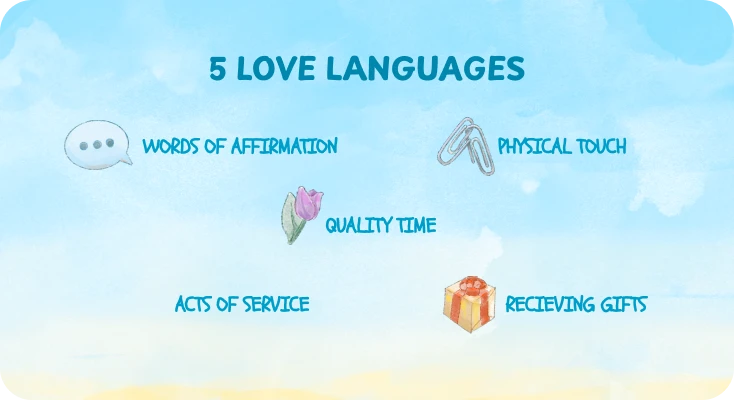I bet you know about the love languages theory. It’s like the Kardashians: you may not follow them, but you’ve definitely heard of them. The book that theorizes about the five ways people want to be loved—their primary love languages—came out over 30 years ago and is still popular. Recently, however, the theory has been increasingly criticized.
According to Gary Chapman and his love languages theory, there are 5 love languages: acts of service, words of affirmation, quality time spent together, gifts received or given, and physical contact for expressing and receiving love. You get one love language as your primary and another as your secondary.
Knowing your own love language or someone else’s love language, like your partner’s or husband’s, strengthens the emotional connection, makes the person feel significant, and overall helps to maintain a healthy relationship.
What is the 5 love languages theory?
The five love languages—a concept from Gary Chapman’s popular 1992 book—has taken the world by storm. With over 20 million copies of the love language book sold globally and translated into over 40 languages, Chapman set out to help people connect and build lasting relationships.
But where did he get the 5 love language list? Chapman, a pastor and self-proclaimed relationship counselor, found that the people he counsels express their love differently, and everyone has their own primary love language.
He discovered that we all have certain types of 5 love languages that influence how we want to give and receive love. These love languages (or how people express this love language) can include physical touch, quality time together, receiving gifts often, acts of service, and even spoken words like words of affirmation.
Gary Chapman suggests people understand that “my partner is not me” and learn to express love in their language, not just their own. This is a very sound approach; we’ll give him that.
5 Love languages list
So, what are the five love languages? Let’s look at how to speak each of them, according to Chapman.

1. Acts of service
Let’s start from the top: the first love language is acts of service. It’s the first one because, according to research by Preply [1], acts of service are actually the favorite language for expressing love in the US.
Whether it’s making breakfast or leaving sweet notes, these small acts are the language of love known as “acts of service.” It’s not about the specific task but the message behind it because, for some people, they’re all acts of love.
They are all about making life easier for that person. This can mean doing the dishes, running errands, letting them sleep in while you play with the kids, picking up their parents from the airport, or planning their weekly meals when they’re tired. The most important thing is that you go out of your way to help.
If acts of service are your primary love language from 5 love language list, hearing “let me do that for you” is music to your ears, especially when a task feels challenging. If it’s your partner’s, you can help with chores, share responsibilities, or simply offer a helping hand.
2. Quality time
Number two is Americans’ favorite language for receiving love, according to the same Preply research [1]. You guessed it—it’s the quality time love language. This isn’t about grand gestures or expensive vacations but about spending undivided time with your partner. If your partner longs for more time together, this could be their primary love language.
The beauty of quality time lies in its simplicity. You don’t have to plan anything elaborate—just take an hour to spend with your partner.
A coffee in the morning, a weekly date, or a walk after work—these moments of undivided attention can make your partner happier. What they don’t like are prolonged separations.
Showing love through quality time to your partner means actively listening, planning activities together, and creating lasting memories. The key is to find simple pleasures you can share.

3. Receiving gifts
No, not everyone who enjoys gifts is materialistic. Often, the people who appreciate this love language are all about the sentiment. They find joy in something concrete, a token that reminds them of love and affection.
With this love language, it’s not the price that matters but the care and effort put into the gift. A well-chosen present conveys the depth of your feelings, while a generic or thoughtless gift suggests the opposite. See it as an opportunity to show that you’ve been paying attention.
When it comes to the gift-giving love language, meaning is vital: focus on thoughtful gifts, crafting something special, planning nice surprises, and making celebrations memorable.
Here’s a tip: keep a list of your partner’s hints and ideas throughout the year, which can serve as a guide for holidays and anniversaries. The most important thing is that you make your partner feel seen, heard, and appreciated with these thoughtful gestures.
4. Physical touch
If your partner speaks the language of physical touch, even small gestures like making eye contact or holding hands can mean the world. A simple hug, a sweet kiss, or a gentle touch on the arm is a tangible reminder that you see and appreciate them.
You don’t need to be all over them to master the physical touch love language. A squeeze before work, holding hands in a quiet moment, or a light touch during a conversation—all these tiny gestures show love for your partner.
5. Words of affirmation
For some, the language of love involves actual words—words of affirmation (expressing affection). These people not only want to hear but also vocalize their feelings, so you’ll often hear “I love you,” “You’re awesome,” and “I’m so glad I found you.”
If your partner loves words of affirmation, you should express your love in face-to-face conversations, text messages, or DMs.
Words of affirmation love language examples here include praising your partner in front of others, using kind and encouraging words, and complimenting them often. Secretly slipping a love note in their pocket also works. These people value open and honest communication and expressions of love, gratitude, and respect.
Now that you’ve unlocked the love languages meaning stage, it’s tempting to think you have the magic key to every relationship door. All these different types of love language are a roadmap for you to understand what kind of attention your partner prefers.
Curious about you being your best? Taking care of your mental health can make a big difference. Breeze offers a free well-being test with personalized tips to help you understand yourself better. It might be a small step towards a happier you.
How to identify your love language
Here are some questions to help you identify your primary love language:
1. Quality Time
- Do you feel most loved when someone gives you their undivided attention?
- Do you enjoy deep conversations or shared activities more than receiving gifts?
- Do you get frustrated when your loved ones are distracted while spending time with you?
2. Physical Touch
- Holding hands, hugging, eye contact, or kissing someone makes you feel emotionally connected?
- Do you find comfort in physical closeness, like cuddling or sitting next to your partner?
- Do you feel disconnected when your partner is physically distant?
3. Words of Affirmation
- Do compliments and words of encouragement mean a lot to you?
- Do you feel appreciated when someone expresses love through kind words or handwritten notes?
- Are you deeply hurt by negative words or not hearing positive words?
4. Acts of Service
- Do you feel loved when someone helps you with tasks without being asked?
- Are small acts of kindness, like making your coffee or running an errand, more important to you than words of praise?
- Do you appreciate it when your partner takes responsibility for chores or responsibilities to make your life easier?
5. Receiving Gifts
- Do you feel special when someone surprises you with a thoughtful gift?
- Do you appreciate when people remember special occasions with a physical token of love?
- Are you more interested in the thought and work that went into a gift than in how much it costs?
Your dominant love language is likely the one where “yes” answers felt the strongest. However, you might have a mix of a few.
How to tell your partner your love language and find out theirs
Nobody’s a mind reader, not even Derren Brown. So, if you want your primary love language to be heard, you have to speak up and explicitly tell your partner what you like. “What’s my love language?” Well, there are several ways to find out.
A little self-reflection and self-awareness are key. Think about what makes you feel most loved. Is it when your partner does something unexpected for you when they take time off work to spend some extra time with you, or is it that Harry Potter-inspired necklace they knew you’d like? These tips will help you define your love language.
But remember, just because we expect a certain form of affection doesn’t mean our partner will understand and, more importantly, enjoy it.
Here’s what you can do to find out your partner’s love language:
- Ask them directly—this is usually the most straightforward way
- Pay attention to how they express their love for you—maybe it’s the way they want to be loved
- Experiment with different love languages to find out which one appeals to them the most
- Look into their previous relationships—they may mention where their ex-partners failed
And finally, don’t worry if your love languages don’t match. Because you know what? The idea of the five love languages isn’t perfect. Here’s why.
Critique of the 5 love language theory
The 5 love languages theory may have millions of fans, but there are critics, too. A recent paper published in Current Directions in Psychological Science critiques the popular love language theory, arguing that it lacks a scientific foundation. The study, co-authored by psychology researcher Gideon Park from the University of Toronto, suggests that categorizing people into fixed “love language” types is arbitrary and unsupported by research. [2]
Psychology professor Paul Eastwick from UC Davis agrees with the analysis, stating that while using love languages can help partners feel appreciated, there is no scientific evidence supporting the idea that “matching” love languages leads to better relationships. Instead, meaningful and effective communication requires more than simply identifying and aligning with a specific love language.
Next, the rigid categorization of five love language types doesn’t do justice to the fluidity and diversity of relationships. There are some people who might feel left out in “The 5 Love Languages” if they are not in a heterosexual relationship or do not identify as heteronormative.
Since Chapman is a pastor at a Baptist church, the concept is geared toward a specific white, Christian, and heteronormative demographic, limiting its relevance to a diverse population. People with PTSD, specific mental health conditions, or neurodiverse people may accept and express love in unconventional ways, but all love languages should be valid if they aren’t abusive.
Some people think that giving your partner space, making them laugh, or getting along with the partner’s friends are also love languages. Why aren’t they on the list? Why not 7 love languages, as another approach suggests?
In the Preply survey, we mentioned that 65% of respondents said their love languages had changed over the course of their lives. Think about it: if a person’s love language is acts of service, does it stay the same when they hire someone to clean, cook, and run errands for them?
And finally, there’s a big problem with dividing love into love languages where some are more important than others. Studies that conducted surveys with couples have shown that people tend to endorse all five as meaningful ways of expressing love, and they vary in context. [3]
When you love someone, all the love languages you know can combine. You can’t have quality time without physical touch, and not getting any words of affirmation from your partner is also rare. Not to mention that physical violence should not be present in any healthy relationship, even if you haven’t read a book that says it’s bad.
Conclusion
Knowing what makes you feel loved and how your partner wants you to communicate romantic feelings is very important. Knowing your primary love language or someone’s primary love language is really important, too. It doesn’t matter if you follow the 5 love languages list. As long as you’re both willing to work on your relationship and choose each other every day, you’ll thrive.
FAQ
1. What is the most common love language among men?
YouGov surveyed 1,000 Americans about their preferences for giving and receiving love, and their results state that for men, the most preferred love language is split by age. [4] Younger men tend to favor quality time, while older men (45+) strongly prefer physical touch as their primary love language.
2. What is the most common primary love language among women?
The YouGov survey shows that women most commonly prefer quality time as their top love language, with 41% of younger women (under 45) and 44% of older women (45 and over) choosing it. Their second most common love language is words of affirmation, especially among older women (24%).
3. Can you have all 5 love languages?
Yes, you can have all five love languages, as everyone appreciates love in different forms. However, most people have one or two primary love languages that resonate most deeply with them while still valuing the others to varying degrees.
4. Can the primary love language change over time?
Yes, someone’s love language can change over time due to life experiences, relationship dynamics, and personal growth. Major life events—such as becoming a parent, experiencing loss, or evolving emotional needs—can shift the way you feel most loved and how you express love to others. It’s important to regularly check in with yourself and your partner to ensure both of your needs are being met and avoid relationship problems.
Sources:
- The most popular love language in each U.S. state, Preply, 2023.
- Impett, E. A., Park, H. G., & Muise, A. (2024). Popular Psychology Through a Scientific Lens: Evaluating Love Languages From a Relationship Science Perspective. Current Directions in Psychological Science
- Bunt, S., & Hazelwood, Z. J. (2017). Walking the walk, talking the talk: Love languages, self‐regulation, and relationship satisfaction. Personal Relationships, 24(2)
- What are Americans’ love languages? Survey, YouGov, 2022.
Disclaimer
This article is for general informative and self-discovery purposes only. It should not replace expert guidance from professionals.
Any action you take in response to the information in this article, whether directly or indirectly, is solely your responsibility and is done at your own risk. Breeze content team and its mental health experts disclaim any liability, loss, or risk, personal, professional, or otherwise, which may result from the use and/or application of any content.
Always consult your doctor or other certified health practitioner with any medical questions or concerns
Breeze articles exclusively cite trusted sources, such as academic research institutions and medical associations, including research and studies from PubMed, ResearchGate, or similar databases. Examine our subject-matter editors and editorial process to see how we verify facts and maintain the accuracy, reliability, and trustworthiness of our material.
Was this article helpful?





